The feeling of a blast from the past is more than evident when you pick up the medium format camera body Hasselblad 907X with its CFV II 50C digital back. Even more so if this back is compatible with Hasselblad's V-System cameras, such as my SWC that I used for some shots in this review. And it is incredible to think how completely mechanical models of over 60 years ago are able to communicate without problems and with excellent results, with the most modern technologies. But before we reveal everything right away, it is necessary to take a small step back and see how this modular system based on the Hasselblad CFV II 50C digital back and the small 907X camera body is made up in detail.
Hasselblad CFV II 50C and 907X digital back review
-
- How the new Hasselblad system is composed
- Field test of CVF II 50C and 907X
- When the Hasselblad digital back meets a SWC
- Conclusions
How the Hasselblad system is composed
It has already been quite some time since Hasselblad had put on show the first prototype of a digital back inspired by the V system. It was displayed in a showcase in all its glory in the Hasselblad booth at Photokina 2016. And the idea of a modular concept, based on the lines of Hasselblad's iconic cameras of the 50s, was already evident at the time.
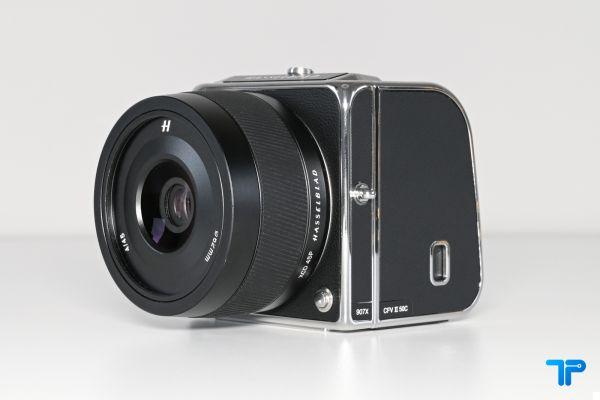
It cannot be denied that in recent years the curiosity to see this project working has increased, rumor after rumor. A long time has passed between development and the actual landing on the market, also because in the meantime the Swedish company has focused heavily on its X1D mirrorless system. And precisely for this reason the first version of the CVF 50C digital back has never seen the light, except in a special black finish to celebrate the anniversary of the moon landing in the summer of 2019.
After another year at Hasselblad they completed and finally put on the market the definitive product, consisting of CFV II 50C digital back and from the very thin camera body 907X. On this system are mounted the optics of the XCD series, those of the medium format mirrorless to be clear.
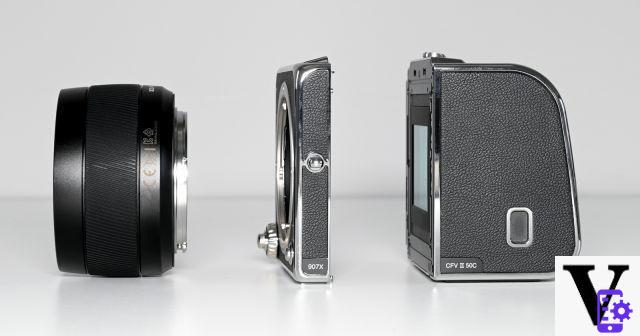
All perfectly in line with the style of the Swedish company, which has always made it possible to assemble bodies, magazines and optics from different vintages together. It is with this modular spirit that Hasselblad has come to this day, offering tools ready to produce the highest quality images in virtually any photographic condition.
The 50 megapixel sensor
The sensor, as the name of this Hasselblad digital back implies, features 50 megapixel and that's exactly what we find on board the X1D II. A certainty therefore in terms of image quality, both for the ability to reproduce details and for the soft tonal passages rich in color shades.
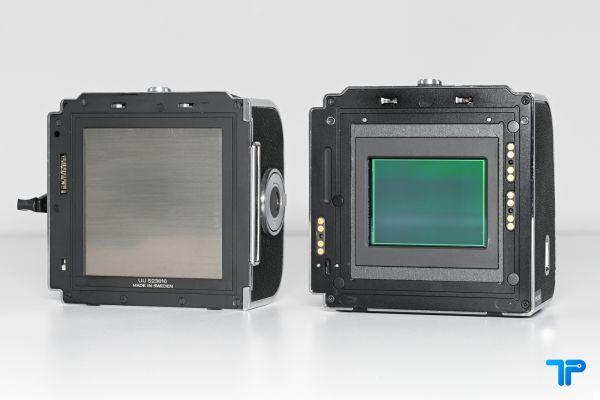
In detail it is a medium format CMOS sensor that exploits 14-stop dynamic range and integrated technology Hasselblad Natural Color. The resulting images are characterized not only by the wide dynamic range, but by an excellent color depth with very natural tones.
Technical features
The sensor is found inside the Hasselblad CFV II 50C digital back, an instrument capable of adapting to both the modern 907x and all Hasselblad V system film bodies. presents with a swiveling display with tactile technology, a dual memory card slot and an internal battery bay. It is all concentrated in an elegant and functional body that now has no backward compatibility problem with the mechanical models of the past. To mount it on a SWC, for example, a small modification was required, while today in a moment we can transform a film camera into a digital one.
The real camera body of this Hasselblad branded system, however, is the 907X, the smallest and lightest ever created. In fact, we are talking about about 200g for a thickness of just 28mm. In this small space there is not much, if not the bayonet for the XCD lenses and the shutter button. This is the emblem of the modular concept so dear to Hasselblad, a body that almost disappears in the union between optics and digital back. To remain tied to this discourse it is also important to remember that on this digital back through the 907X and the appropriate adapters we could also use other optics. In particular, there are 3 adapters in the Hasselblad catalog, through which the V, H and XPan series lenses can also be mounted on the XCD mount.
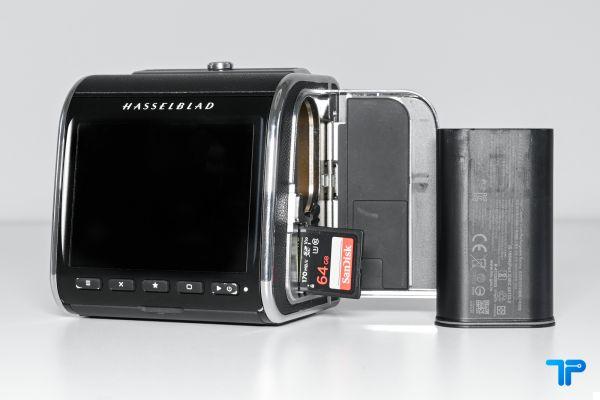
Given that we are dealing with a really small medium format kit for this standard, in practice it is comfortable. Almost all the settings can be adjusted through the touch panel, responsive and practical to use. The few direct commands that we find on the camera body are integrated in the lower part of the display. On the 907X body, however, we find the shutter button surrounded by a ring to adjust the exposure values and one that allows us to access exposure compensation or, in manual mode, shutter speeds.
Finally, under the display, an elegant door hides the sockets that we have available on this digital back. In particular, the most common sockets for headphones and the microphone to which are added the flash connection and one dedicated to use with ELX bodies. You may be wondering if there is also a USB port. The answer is yes, on the left side of the body and through this interface we can connect our digital back from a computer. With the proprietary software, Focus, we can also shoot in tethering as well as obviously converting RAW files.
The management of the digital back
In practice, you find yourself shooting from the height of the waist, as it used to be. The swiveling display is used just like a cockpit, but in addition we have the convenience of autofocus and a touch panel.
The menu is very intuitive and comes with a first screen that contains the main settings in the form of icons. In addition to those present by default we can add others to build our menu. Each icon, then, corresponds to a submenu that contains all the possible functions relating to the main category. The whole is very clear and practical.
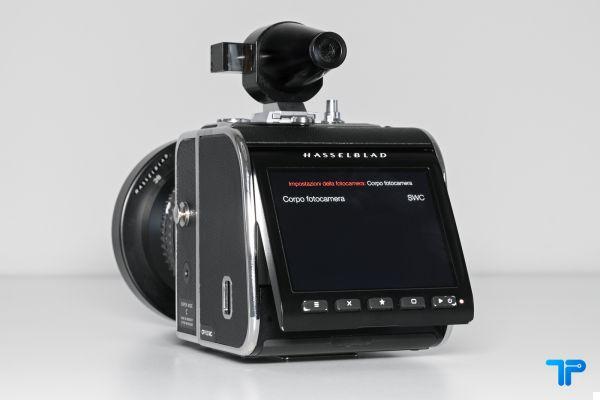 As soon as you press the shutter button halfway, then, the display will show us all the shooting settings and with simple operations we can change all the parameters. Once this part has been completed, the moment of shooting finally arrives. Live View starts and we can proceed with the composition of the scene and the fateful click.
As soon as you press the shutter button halfway, then, the display will show us all the shooting settings and with simple operations we can change all the parameters. Once this part has been completed, the moment of shooting finally arrives. Live View starts and we can proceed with the composition of the scene and the fateful click.
Hasselblad CFV II 50c digital back: the field test
I have already told you that this back is equipped with the same sensor as the X1D II 50C, but in reality it is almost the same camera but in a different guise. In fact, it brings with it strengths and even some defects, in particular on the focus. The system is based on the contrast detection and is slow in fulfilling his duty. The 117 points of focus, however, leave us some freedom, but it is not the right camera to capture the moment on the fly. We have to select the point where we want the focus on the display, wait about half a second and then we will have our photo.
However, that this modular system was not born for sports photography is evident and no one pretends that it is. Contexts such as still-life, landscape and architecture are those in which we can really exploit their full potential.

In the cold days of the beginning of the year, I was able to bring this modular system to the streets of Milan, to try to test it in a situation that is not exactly like the ones I have just mentioned.
And if I have already talked about the main defect, if we can call it that, the advantages inherited from X1D II are varied. What is immediately appreciated is the quality of the files produced, rich in details, shades of color typical of a sensor of this size. Another aspect that makes medium format fascinating is the detachment of the tops. Even with a lens that is not as bright as the 45mm f/4 XCD at the maximum aperture we have a reduced depth of field and “plastic” results. Even the most complex images are able to bring out all the details of the focus area chosen by the photographer, but giving an unparalleled depth with smaller sensors.
Excellent performance even in difficult conditions, such as a backlight. In this case what we have to pay attention to again is the focus. Contrast detection is not as reactive as phase detection, especially when the lighting conditions are not perfect. But when you try your hand at static subjects, with a little patience, the results we get are mouth-watering. The quality of XCD optics is very high and able to counter chromatic aberrations and minimize ghosting and reflections inside them.
We find some small differences with the sister X1D II in the yield only when we raise the ISO. In fact, at higher sensitivities there would seem to be a slight increase in noise. I'm talking about very high values, over 12.800 ISO, so it's just to look for the famous nit.
When the Hasselblad digital back meets a SWC
During the test of the Hasselblad CFV II 50C and 907X digital back I could not help but try all this technology concentrated such a small body on my Hasselblad SWC (Super Wide Compur). The idea of exploiting the quality of the optics Biogon 38mm of one of Hasselblad's most iconic cameras, coupled with the computing power of the modern sensor is something I've been waiting for since the first prototype in 2016.
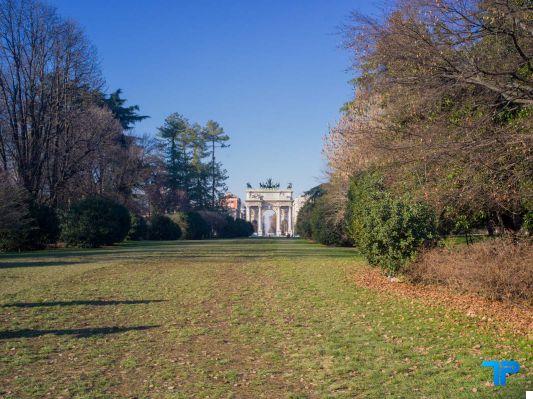
Once the original stock for the film has been replaced with the digital back we are ready to shoot if we want to have a completely analog experience. The difference will only be that of being able to immediately admire what is photographed in the display. Working in this way means composing the scene with the SWC viewfinder and working with the hyperfocal technique for focusing. Times and apertures will be adjusted directly on the lens. In this case, however, we can rely on the detailed distance scale on the Biogon 38mm. And I must admit that the feeling of pleasure with each click was great.
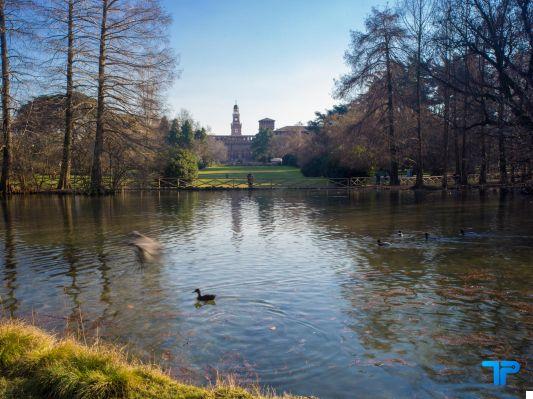
If, on the other hand, you would like to take advantage of the Live view, there is a few more steps to take. First you need to select the body you are using in the appropriate section of the menu. So far everything is easy, also because the setting will remain in memory and even continuing to switch from the mechanical body to the 907x will not be changed. The next step is to set the release mode to T, which keeps the shutter open, choose the desired aperture and take advantage of the pose B. On the back screen just select the Live View item and as if by magic even with an old SWC we will see live what we are framing.

Working in this way is surprising, also because despite the years the Biogon 38mm optic still does an excellent job at almost any aperture. We lose the traditional square format, okay, but we can count on variable ISOs and the ease of handling of this back. A really successful combination that, if you are ready to give up a few megapixels, can also make you take square images. With a small crop on the sensor, which can be activated from the menu, we can also return to the original appearance.
He could not miss a little comparison yield between the fully digital version and the one with SWC. What you notice is a different rendering in terms of colors and details. The CFV II 50c and 907x version offers colder results and greater engraving on the finest details. Overall, however, the results obtained by mounting the Hasselblad digital back on SWC are really full of charm, they really seem shot on film and not using the computing power of a 50 million pixel medium format sensor.
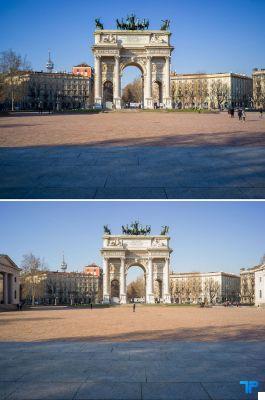
Already from the original images you can see a greater contrast in the photograph taken with the back mounted on 907x. There is also an evident difference in the rendering of tones, colder and fuller the digital ones, warmer and more washed out those obtained with SWC. However, since these are RAW files, know that there is ample room for work. The files that I show you have simply been transformed into JPG without any intervention, but using Focus or any other software compatible with Hasselblad's uncompressed format you can easily smooth out the final results.
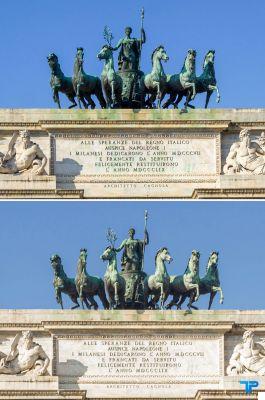
Going to look in more detail the differences are noticed. But I am sure that if we just looked at the SWC result without having the term of comparison immediately above, we would be much more impressed than that.
Conclusions
The review of this Hasselblad CFV II 50C digital back and 907x ends as it began, with a few years back. This time until 2013, the year in which the same Swedish company had considered the life cycle of the V system as finished.
It took several changes at the top to find the right balance and the way forward, but in the end the results came. Hasselblad today is owned by DJI, but the headquarters are still in Gothenburg as well as the production plant where everything is done with the utmost care. Including the back, the camera body and the optics of this modular system that I really liked.
Price
The operation is aimed at a nostalgic audience that still has one of the mechanical cameras compatible with this system in the drawer. But not only that, the price is in fact relatively affordable, so much so that it acts as an entry-level kit to the world of medium format for Hasselblad.
With around 6600 euros you can take home the digital back and the 907x.
For this reason, in reality, the company's gaze goes far beyond the nostalgic of the film. As I have already reiterated the beauty lies in its being a modular system, easy to use and which ensures quality in almost any field. It is not perfect nor for everyone. But it is something that could also excite the imagination of those who have never seen a cockpit camera!
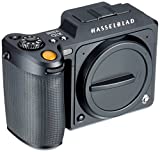 Hasselblad X1D-50C Black, Medium mirrorless camera ...
Hasselblad X1D-50C Black, Medium mirrorless camera ...
- 50 Megapixel CMOS sensor type
- Color definition: 16 bit
- Exposure time interval: From 60 minutes to 1/2000 of a sec


























